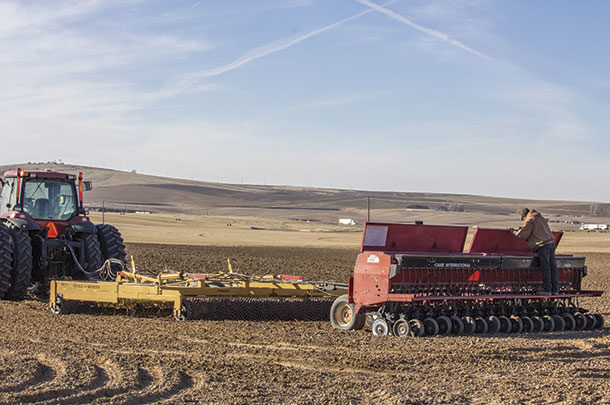Perhaps the best origin is based in the story that early carpenters became so expert in their craft they no longer needed to measure their wood before making a cut. According to some sources, they (the carpenters) knew the width of their thumb – some say the length from knuckle to end of thumb – and so they simply made their cuts based the estimate of the size of the thumb. No ruler needed, hence the phrase “rule of thumb.”
The source of farmer colloquialisms seems to stem from a slower age when much of the fieldwork was done from a tractor without a cab – or sometimes from a steel seat located behind a horse or two. During this romantic and golden age of agriculture, farmers/agronomists became applied scientists and were able to put a phrase to something they had observed as they spent hours and days in the field.
We have made an attempt to categorize rules of thumb and colloquialisms we have heard over the course of our years in agriculture. Similar to the old-time carpenters, we like to think the very best farmers and agronomists came up with these phrases or rules that can still guide forage management decisions today.
Rules of thumb
1. Plan ahead – Get the soil tests in advance, work on the drill in advance, control weeds in advance, don’t use herbicides in the previous crop that could have carryover into the alfalfa crop.
2. Soil test – Often new seedings of alfalfa follow annual crops such as corn or small grains. When a perennial crop (such as alfalfa) is planted, and no future soil disturbance is anticipated for several years, it is appropriate to add phosphorus or potassium at rates that can be incorporated and utilized over a period of several years (most often two years).
3. Control perennial weeds before planting – Established perennial crops such as alfalfa tend to favor the development and growth of perennial weeds. Control perennial weeds with herbicides that are not selective in alfalfa and tillage practices before the alfalfa is planted.
4. Fall planting date – Fall planting is great because the crop is up and ready to grow in the spring, and no time is lost before the first harvest. Killing frosts in the fall influence seeding date. Seed early enough so the alfalfa has at least the unifoliate leaf unfolded. (This is about 50-50 success.) More desirable is the first trifoliate leaf expanded and the plants about 3 inches tall. The best option is three leaves and 3 inches tall. Plan back from the first severe frost to select the appropriate date to plant.
5. Spring planting date – Plant in the spring as early as it is possible to get on the ground without damaging the soil. Spring rain can delay planting. If necessary to gamble between cold weather and no rain, plant when there is moisture and take a chance on the cold weather.
6. Prepare an appropriate seedbed (rule of boot) – Most crop failures related to seeding are the result of seeding too deeply. Prepare a firm seedbed. The “rule of boot” states a farmer wearing shoes with a heel should be able to see the imprint of the heel and the sole of the shoe or boot, but the arch should not show in the soil. If the arch shows, the seedbed is too soft. When in doubt, more firm is better.
7. Buy and use certified seed – Good-quality seed is an investment in the future. Seed with low germination, contaminant weed seeds and the wrong genetics is a multi-year mistake. Use certified seed to obtain genetic purity and clean, highly viable seed.
8. Calibrate your drill – Alfalfa seed is expensive. Planting too much per acre is an unneeded expense, and planting too little results in unacceptably poor stands. Buy the right amount of seed and get it evenly distributed across the field.
9. Use inoculated seed – Even when planting into soil that has previously grown alfalfa, it is cheap insurance to use inoculated seed to ensure effective nodulation.
10. Select an appropriate seeding rate – Traditional seeding rates have changed because of improved seeding equipment. Choose a rate that is based on past experience, the standard in the neighborhood, soil type and irrigation. If broadcast seeding and working the ground afterward with a harrow, increase the seeding rate by 20 percent to account for seed planted too deeply or too shallow.
11. Seeding depth – Seed should be planted so it is 2.5 to five times the depth of the width of the seed. On sandy soils, it is OK to seed deeper. On clay soils or soils that crust, plant more shallow. When faced with the decision to plant too deep or too shallow, go with too shallow.
12. Use press wheels or drag chains or roll the field – In order to germinate properly, the seed must make good contact with the soil. Seed planted in “fluffy” soil germinates into pockets of air, and roots do not anchor the plant well or absorb adequate moisture – and crops die.
13. Control weeds in seedling crop – When alfalfa plants emerge, plan to make necessary weed control treatments while the crop is in the appropriate stage of growth. Some selective post-emergence herbicides are effective in controlling seedling weeds in alfalfa, but the weeds have to be small. Some weeds can be killed when they are a half-inch diameter but are missed if they are three-fourths of an inch in size.
14. Rule of hat – After alfalfa is planted, decisions about the quality of the new stand need to be made. If the seeding is successful, there should be 20 to 25 seedlings per square foot. A traditional baseball cap is approximately one-half a square foot (counting the area for the head and the brim). To determine the effectiveness of the stand, a farmer should throw the hat at random intervals and then count the seedlings under the hat. If there are 10 to 12 seedlings under the hat, the stand is acceptable.
15. Thickening the stand – When the stand is determined to be too thin, there is a great temptation to try and thicken the stand by drilling more seed through the field. If the seeding is done very soon (within weeks) after emergence of the thin stand, this may be successful. However, alfalfa produces toxins that kill other alfalfa plants (auto-allelopathy). Thickening up older stands is almost always a failure – too much autotoxin in the soil and near plants affects newly germinated plants. ![]()
PHOTO: Planting alfalfa. Photo by Lynn Jaynes.
Earl Creech is an extension agronomist at Utah State University. Email Earl Creech
Ralph Whitesides is a retired professor and extension weed specialist with Utah State University
Additional phrases
- Alfalfa doesn’t like wet feet – Alfalfa likes deep, well-drained soil, prefers a pH range of 6.2 to 7.8, does not do well on shallow soils or soils with hardpans, and fields with a seasonally high water table are undesirable.
- Plant more pelleted alfalfa seed – Plant 20 to 30 percent more pelleted or coated seed by weight than uncoated seed. The coating adds weight to the seeds that must be considered in the planting rate.
- If you plant with a grain drill, use a drill with an alfalfa box –
Too much seed is dropped from the grain box when seeding alfalfa, as the openers in the bottom of the drill cannot be closed tight enough.
- Only use a companion crop if you have a good reason –
A good reason is wind or water erosion and crusting. If it is necessary to use a companion crop, use a light seeding rate (10 to 15 pounds per acre) of a grain such as oats that is not very aggressive, has narrow small leaves and will not be a competitor to the alfalfa.
- Don’t disk or plow up a new stand too early – Alfalfa has enough hard seed that sometimes a newly seeded stand can withstand a serious frost and still develop enough plants to have an acceptable stand. Don’t give up on the stand too soon.










